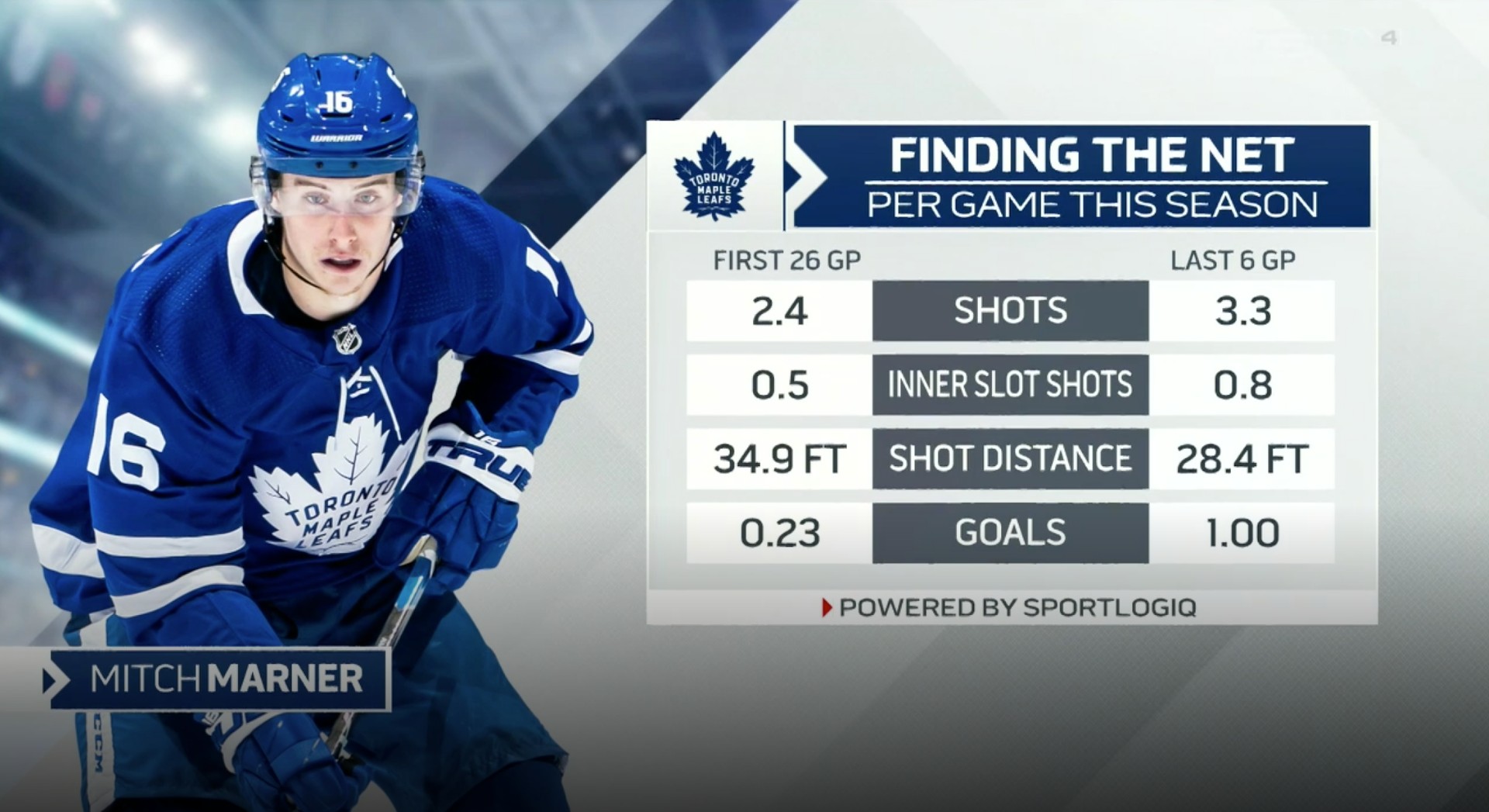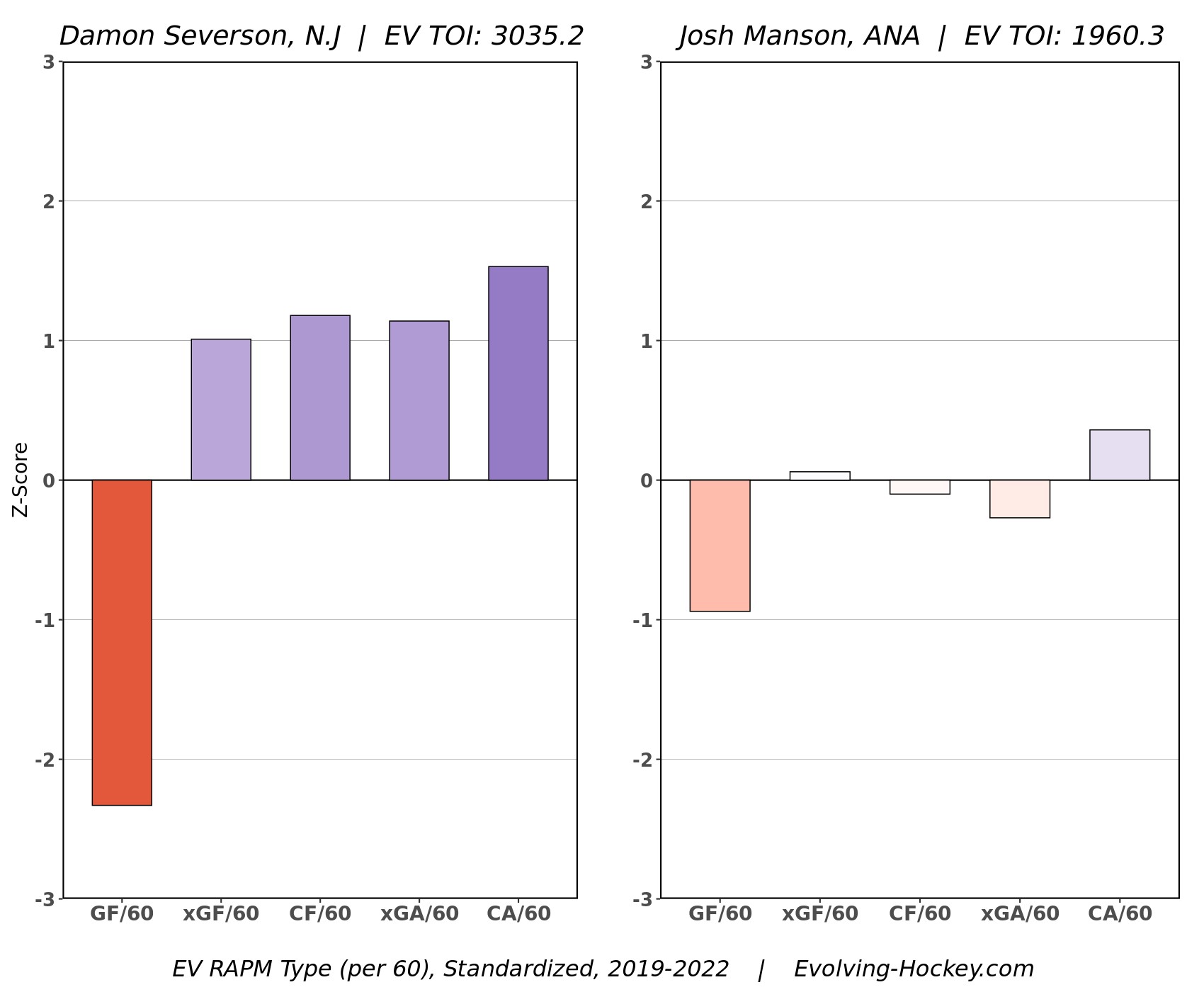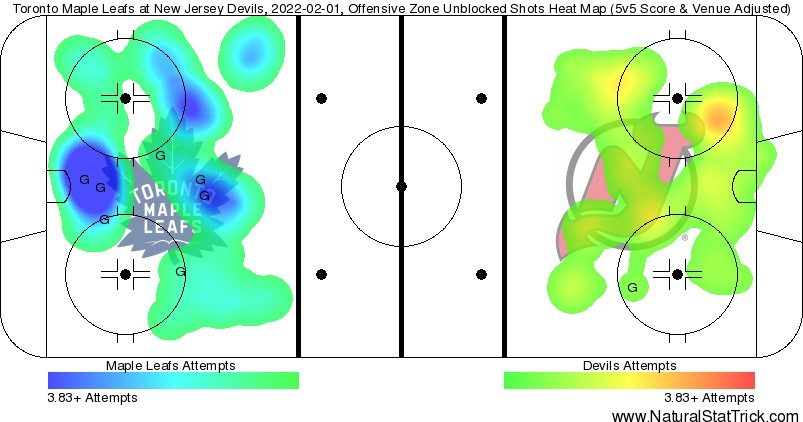At least they kept it close!
After Monday night’s dramatic third-period comeback, the Leafs followed it up with a more one-sided affair on Tuesday evening. The score was 4-0 after one period, 6-0 after two, and 7-1 by the final buzzer.
As someone who loves diving into the nitty-gritty, whether it’s tactics or the numbers, this game was so lopsided it makes it difficult to really analyze. One team showed up; the other didn’t. Ray Ferraro put it best when he described it as New Jersey conceding “easy ice” to Toronto and not being hard on pucks, which made them an easy team to play against, especially in the offensive zone.
The Leafs‘ red-hot offense, led by four goals from its top line of Bunting – Matthews – Marner, took full advantage with a committed performance from the drop of the puck. It would’ve been easy to look past this rematch against New Jersey in a back-to-back after a win the night prior, with a break in the schedule to look forward to. The Leafs took care of business as an elite team should, all but putting this game to bed within about 15 minutes.
All told, the Leafs received even-strength goal production from three of Sheldon Keefe’s “optimal” forward lines, including six different goal scorers (Marner x2, Engvall, Spezza, Matthews, Kampf, and Bunting). The only line not to produce tonight was the trio that Sheldon Keefe started for the opening faceoff in all three periods: The Tavares line, which was also on for the only goal against, albeit it came early in a third period that was essentially 20 minutes of garbage time.
In net, Jack Campbell turned aside 32 of 33 shots in what was his best start (statistically) since his shutout a full month ago against Ottawa.
Now winners of five straight, the Leafs pretty well ticked all of the boxes heading into the break.
Instead of going through each player individually like we usually do in the postgame report cards, I’m going to try something new tonight. I’ve picked three major storylines from tonight’s game that I wanted to dive into with a bit more detail than I’m usually able to in the report card format.
It might work out great, or it might be a disaster. Who’s to say? Much like the Leafs spreading their talent across three lines, though, we won’t know until we try it! And who knows, maybe it’ll last more than a game and a half.
Buckle up folks, it’s time for some Leafs…analysis.
Mitch Marner’s Revenge Tour
He’s been the biggest storyline in this market ever since his infamous contract negotiation of 2019, paying him a tier above his comparables in Brayden Point, Mikko Rantanen, Sebastian Aho, and Matthew Tkachuk. From the second that contract was signed, it was never realistic to ever expect Marner to outperform those comps to the extent his cap hit suggests he should, and as a result, he’s become the whipping boy in Toronto.
A dry spell in the playoffs didn’t help matters much. Neither did a slow start to the 2021-22 season by his standards, but Marner is back to playing some of the best hockey of his life right now. Since returning from his quarantine, he has 16 points in seven games, including a career-high seven-game goal streak. What’s great about a lot of those goals is that they haven’t been tap-ins — he’s been beating NHL goaltenders clean from the high slot.
“Grip it and rip it” is how Marner has described his mentality lately, which is nice to see. Eventually, this hot streak is going to come to an end, but it’s been a good sign that Marner has been able to skate himself into good spots in the offensive zone and take some higher-percentage shots. The broadcast did a great job breaking that down using some data from Sportlogiq.
His shot generation and shot quality have both improved significantly since his return. Even when his shooting percentage falls back down to earth, he’s doing a lot of the right things that lead to goals — and we all know what he can do as a passer.
Lil' give & goal #LeafsForever pic.twitter.com/PcOze4ewWS
— Toronto Maple Leafs (@MapleLeafs) February 2, 2022
He’s scored at a 95-point pace over his last three seasons and it doesn’t look like he plans on slowing down anytime soon. This last stretch of play has him on pace for 92, so it’s probably only a matter of time before he climbs his way back up to the mid-90s.
The Michael Bunting Contract
Everyone’s favourite Scarborough pest picked up another set of points tonight and easily could have had a few more.
Michael Bunting was robbed of two assists tonight. He was integral in freeing up the puck on both of Marner’s goals and wasn’t credited with an assist on either one.
Just a good example of all the little ways that he helps to create/sustain offense that can go under the radar.
— Nick Richard (@_NickRichard) February 2, 2022
He’s done so much to provide value for Toronto on his $950k cap hit, which makes it crazy to think he’ll be doing the same thing next year at the same price tag. We all know he could drive hard to the net and win some puck battles in the corners, but his ability to make plays with the puck on his stick and complete passes to his skilled linemates is what’s stood out the most to me. We saw examples of Bunting’s doggedness in his puck pursuit combined with a few skilled puck touches on all four of the top line’s goals tonight.
There is also his penalty drawing prowess. He drew another one tonight after getting cross-checked into the boards by who else but Damon Severson (more on him in a minute). That gives Bunting 26 drawn penalties on the year, tying him for first in the league with Connor McDavid. As a side-note, Nazem Kadri is tied for third in the NHL with 24, so maybe there isn’t as much to the “refs catching onto him” theory as we think.
Just to clarify, Bunting is tied for first in the NHL in penalties drawn, ranks first on the Leafs in 5v5 points per 60, and is controlling over 62 percent of the expected goals alongside Matthews at even strength. Did I mention he’s under contract next season for $950k?
The Nick Ritchie signing was obviously a big whiff, but Michael Bunting’s steal of a contract more than makes up for it.
Damon Severson
I recently watched that “Bad Sport” docuseries and saw the episode on ASU point shaving, then watched Severson play these past two periods (yesterday’s third and today’s first) and I dunno man
— Justin Bourne (@jtbourne) February 2, 2022
So here’s the thing: he’s made two monumentally bad plays in back-to-back games against the Leafs that have resulted in goals against. That’s an undeniable fact.
You wouldn’t be blamed for watching #28 in red closely these last two nights, hoping that a Muzzin-Severson second pair would be the answer in Toronto, and coming away mightily disappointed with his play. I’m not going to pretend he looked good in either game because he didn’t.
What I would like to do is break down his 5v5 impact over the last three full seasons because I strongly believe in valuing the larger sample of who someone is rather than falling victim to recency bias. In the sport of hockey, there are hundreds of split-second decisions you have to make throughout the course of a game, thousands throughout a season, and millions throughout a career. I’d hate for Severson’s two most recent blunders to be how you remember him as a player, but I also know it’s likely the case for most Leafs fans right now.
Part of the reason I like using data to evaluate players is that it can help us cut through some of these biases, putting aside that one “big mistake” or two that stick out in our mind and making an assessment based on all of the decisions a player has made to impact the outcome of a game.
When we do that, Severson stands out as one of the better play-driving right-handed defensemen in hockey.
If you’re unfamiliar with these charts, those blue lines indicate that Severson has had an above-average impact on offense and defense at 5v5 over the last three seasons (168 NHL games), ranking about one standard deviation above the mean — or the 84th percentile if that makes more sense to you.
That giant red line indicates that the actual goals haven’t been going in; he’s two standard deviations below the mean at impacting goals for — or the fifth percentile.
I’m sure you’re ready to argue that the difference between his actual and expected goals can be explained by poor defensive play (i.e. his 2v1 defense the other night), but he’s actually right around league average in terms of allowing goals against at 5v5 over that timespan. Of all things, it’s the offense that’s holding back his goal differential.
Thanks to Travis Yost’s research from a few years back, we know that there’s absolutely no repeatability when it comes to NHL defensemen impacting shooting percentage from one year to the next.
With this in mind, I think it’s fair to conclude that Severson has been getting screwed over by his forwards. He’s consistently been moving the puck up the ice to them, ranking as one of the better puck-moving and play-driving NHL defensemen over the last few seasons, but his forwards haven’t been converting on those chances.
Taking all of this evidence into account, I’m still confident that Severson is an above-average NHL defenseman despite his occasional blunders. In a lot of ways, he reminds me of Jake Gardiner, which is probably a sore topic for most Leafs fans, but both players achieved positive results at 5v5 by consistently advancing the puck up the ice with possession.
I know how poorly Severson has played in these last two games, but I also know how well he’s played over his last 168. If I’m Kyle Dubas right now, he’s still the player I’m targeting given that he has an extra year on his contract at an affordable $4.1 million cap hit. If anything, his trade value has probably dropped thanks to those two big mistakes.
Heat Map
Here’s a quick look at where each team’s shots were coming from at even strength, courtesy of Natural Stat Trick.
I was surprised to see the Leafs “only” controlled 58 percent of the shots, 61 percent of the chances, and 65 percent of the expected goals in this game. That was after adjusting for score effects, but it’s pretty tough to account for context when the score is 4-0 after 15 minutes of hockey.
Game Score
Game score is a metric developed by The Athletic’s Dom Luszczyszyn to measure single-game performance. You can read more about it here.
That Marner game score might not be Mason Marchment good, but it’s the highest I’ve seen in a while.
Tweets of the Night
Mason Marchment's Game Score tonight was 9.78 (!!!)
I have *literally* never seen one that highOn top of scoring six points, he was plus-6 and had a 92 percent expected goals rate
— dom at the athletic (@domluszczyszyn) February 1, 2022
I had to pull this up because of how absurd it was. The Marlies essentially built him from scratch in a lab, so it’s unfortunate Toronto didn’t get to reap the benefits of his development. At the same time, did you honestly think he was going to become a top-nine NHL player when the Leafs moved on from him?
I know I didn’t.
Since their "soft and purposeless" loss in New York, the Maple Leafs have won five straight, outscoring the opposition 26-13.
— luke fox (@lukefoxjukebox) February 2, 2022
Negative reinforcement works, apparently. Don’t tell my boss.
I loved the guy but I’ve found myself grateful for most of the year that we didn’t buckle and pay hometown favourite Hyman 5+M per year like 90% of GM’s would have.
— Active Stick (@TheOakLeafs) February 2, 2022
They almost did, too. It’s easy to see why Kyle Dubas & Co. would want to keep Hyman on a TJ Oshie type of contract (eight years x $5 million), but Bunting’s success this year is proof that it’s the star players really dictating the outcomes.
You don’t need to pay Matthews’ complementary winger big money. Just keep the revolving door of cheap depth guys rolling — it’s how you remain a contender in a cap world.
??? pic.twitter.com/Q7wyb30QsT
— Acting the Fulemin (@ATFulemin) February 2, 2022
The worst lead in hockey.
This is an A+ answer on analytics from Poles that everyone should listen to. Applicable to all sports. pic.twitter.com/okw8locEHF
— Jordan Lazowski (@jlazowski14) February 1, 2022
Not a Leafs or even hockey-related tweet, but considering how often I use data in my analysis, this might be my favourite 30-second clip explaining why we can benefit from using extra information to inform our decision-making.







































